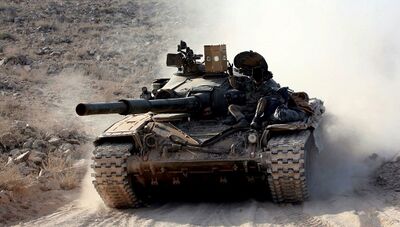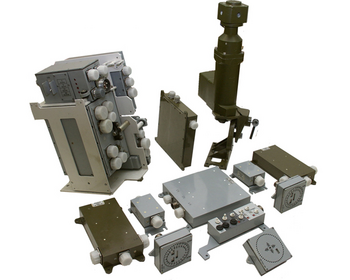Saraab active protection system: Difference between revisions
No edit summary |
No edit summary |
||
| Line 8: | Line 8: | ||
==History== | ==History== | ||
Experiences of the Riysian Ground Forces in the Unification War, as well as of other armies in conflicts through the 1970s and 80s, showed the vulnerability of even the best protected tanks to anti-tank missiles and precision-guided munitions. These technologies posed a very real threat in the minds of the Hay'at al-Arkan, which accelerated research in missile countermeasures, which eventually led to the concept of an active protection system. This first saw light in the form of the '''Nadi-1''' defensive aids system, which combined the Nadi LWR with the Sadeem smoke launcher, and was subsequently augmented with an optoelectronic jamming system and computer to create the first generation Saraab-1 package. | Experiences of the Riysian Ground Forces in the Unification War, as well as of other armies in conflicts through the 1970s and 80s, showed the vulnerability of even the best protected tanks to anti-tank missiles and precision-guided munitions. These technologies posed a very real threat in the minds of the Hay'at al-Arkan, which accelerated research in missile countermeasures, which eventually led to the concept of an active protection system. This first saw light in the form of the '''Nadi-1''' defensive aids system, which combined the Nadi LWR with the Sadeem smoke launcher, and was subsequently augmented with an optoelectronic jamming system and computer to create the first generation Saraab-1 package. Much of the electronics design was done by Haraytan Mikroelektroniat. | ||
When development of the Saraab began is unclear, but it seems that it was developed very rapidly, suggesting that work started in the late 1980s or early 1990s. Work on the system was finished some time in the 1990s, too late for the first batches of [[TR-96]] tanks, but was soon included as standard equipment. Later on, most of the Riysian Ground Force's tanks, including older models in storage, were refitted with the package. | When development of the Saraab began is unclear, but it seems that it was developed very rapidly, suggesting that work started in the late 1980s or early 1990s. Work on the system was finished some time in the 1990s, too late for the first batches of [[TR-96]] tanks, but was soon included as standard equipment. Later on, most of the Riysian Ground Force's tanks, including older models in storage, were refitted with the package. | ||
| Line 28: | Line 28: | ||
===Saraab optoelectronic suppression unit=== | ===Saraab optoelectronic suppression unit=== | ||
The main and most visible component of the active protection system is the optoelectronic suppression unit, or simply the infrared jammer, which is also believed to be designated "Saraab" by the | The main and most visible component of the active protection system is the optoelectronic suppression unit, or simply the infrared jammer, which is also believed to be designated "Saraab". Nicknamed "hats" or "bird houses" due to their shape and location on the tank, Saraab jammers work by radiating pulsed infrared light, mimicking the missile tracking beacons found on SACLOS missiles. This causes the firing post's computer to reject the missile in favor of the jammer, which leads to the missile losing guidance or being fed erroneous commands. | ||
Three generations of Saraab suppression units have been identified. | |||
First generation jammers are simple, | |||
Before developing the , it appears that | |||
===NIL-D Nadi laser warning system=== | ===NIL-D Nadi laser warning system=== | ||
Revision as of 03:08, 25 January 2020

Saraab (سراب, Mirage) is a Riysian active protection system (APS) for protecting vehicles against anti-tank missiles, precision munitions, and guided artillery shells. Adopted some time in the late 1990s, it has since become widely available throughout the Riysian Ground Forces, due to its low cost and adaptable design. The estimated cost of a full system for a tank is $29,200, and its effectiveness against modern SACLOS ATGMs such as the TOW-2 or MILAN 3, is stated to be 80-90%, while its effectiveness against guided artillery shells is 70-75%.
It is mostly installed on tanks, but some of its components - primarily the optoelectronic suppression unit itself - can be installed on virtually any combat vehicle, and even fixed positions and trucks. This is possible due to the modularity of the Saraab system, which consists of several discrete subsystems that can be put together or swapped out as desired. At a minimum, a Saraab system consists of the Saraab optoelectronic suppression unit and a control panel; a full package adds a laser warning receiver, smoke laying system, and several displays for the crew.
Typically, Saraab is controlled by the tank or vehicle commander.
History
Experiences of the Riysian Ground Forces in the Unification War, as well as of other armies in conflicts through the 1970s and 80s, showed the vulnerability of even the best protected tanks to anti-tank missiles and precision-guided munitions. These technologies posed a very real threat in the minds of the Hay'at al-Arkan, which accelerated research in missile countermeasures, which eventually led to the concept of an active protection system. This first saw light in the form of the Nadi-1 defensive aids system, which combined the Nadi LWR with the Sadeem smoke launcher, and was subsequently augmented with an optoelectronic jamming system and computer to create the first generation Saraab-1 package. Much of the electronics design was done by Haraytan Mikroelektroniat.
When development of the Saraab began is unclear, but it seems that it was developed very rapidly, suggesting that work started in the late 1980s or early 1990s. Work on the system was finished some time in the 1990s, too late for the first batches of TR-96 tanks, but was soon included as standard equipment. Later on, most of the Riysian Ground Force's tanks, including older models in storage, were refitted with the package.
Design
Saraab consists of a central computer, optoelectronic suppression unit, and a control panel at its base, to which additional subsystems can be connected or swapped out. The digital computer is the centerpiece of the APS, where it interprets commands from the control panel, manages and directs the active components and countermeasures, manages the built-in test equipment, and outputs information to any connected displays. Though modular, the Saraab APS is not based on an open architecture, so only a limited range of systems can be coupled to the system's computer.
From his station, the commander uses the Saraab's control panel to operate the APS. Sections of the panel are color-coded to help with memory; the light-grey right side contains switches and lights for the suppression unit, the left side controls the Sadeem smoke launchers, and the dark-grey middle section is for turning the system on/off and diagnosing faults.
In addition to the control panel, there are three displays associated with a full Saraab system - one for the commander, gunner, driver. Both the commander and the gunner get a main display, indicating the direction of the laser or radar irradiation source, the type of laser detected (eg. rangefinder, designator, and if the source is vertical), the suppression unit's status, the status of the smoke grenade launchers and number of grenades left, and the operating mode with diagnostics results. The driver's display also shows the direction of the illuminator, and offers directional indications for avoiding the threat and moving under the cover of smoke, based on environmental data from a mast.
As of 2020, there are four known Saraab packages deployed:
- Saraab-1A/B: First generation optoelectronic suppression unit, NIL-D Nadi LWS, and RDD-1 (A) or RDD-2 (B) Sadeem smoke grenade launchers. Largely created from the adding of the suppression unit and computer to Nadi-1 systems.
- Saraab-2A/B: Second generation suppression unit, NID Nadi-2 ESM, and RDD-1/RDD-2 Sadeem smoke system.
- Saraab-3A/B: Third generation suppression unit, NID Nadi-2 ESM, and RDD-1/RDD-2 Sadeem smoke system.
- Saraab-4A/B: Second or third generation suppression unit, NID Nadi-2 ESM, RDD-1/RDD-2 Sadeem smoke system, and passive laser deception system. Existence confirmed in 2020, refers to earlier packages supplemented with the passive laser jammer.
Saraab optoelectronic suppression unit
The main and most visible component of the active protection system is the optoelectronic suppression unit, or simply the infrared jammer, which is also believed to be designated "Saraab". Nicknamed "hats" or "bird houses" due to their shape and location on the tank, Saraab jammers work by radiating pulsed infrared light, mimicking the missile tracking beacons found on SACLOS missiles. This causes the firing post's computer to reject the missile in favor of the jammer, which leads to the missile losing guidance or being fed erroneous commands.
Three generations of Saraab suppression units have been identified.
First generation jammers are simple,
Before developing the , it appears that
NIL-D Nadi laser warning system
Entering service in 1985,
